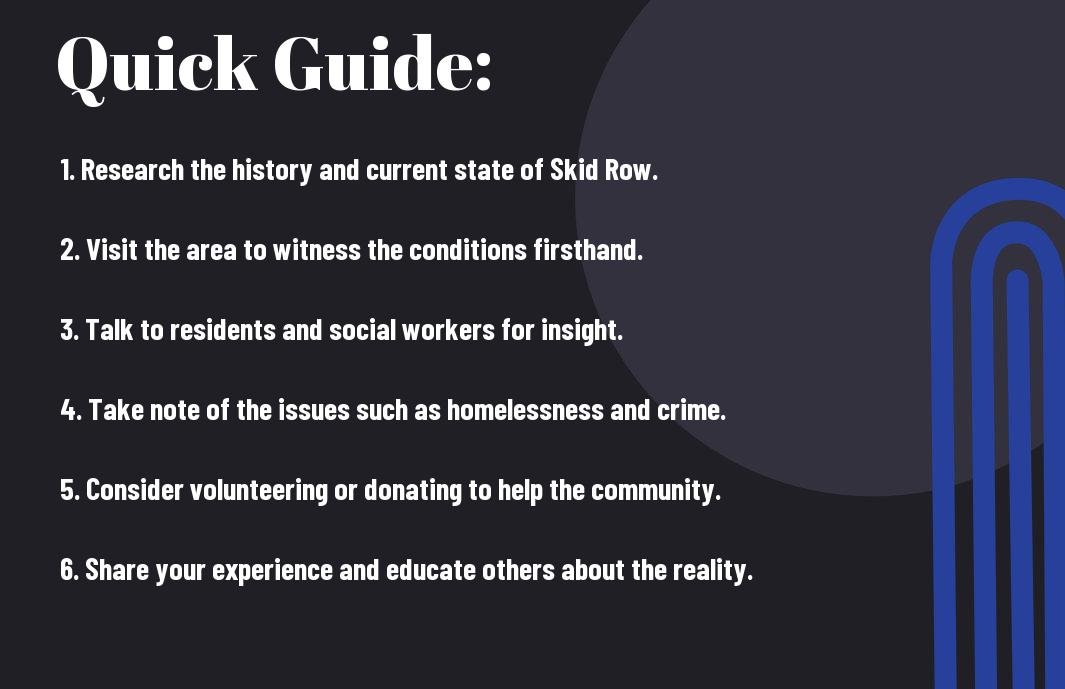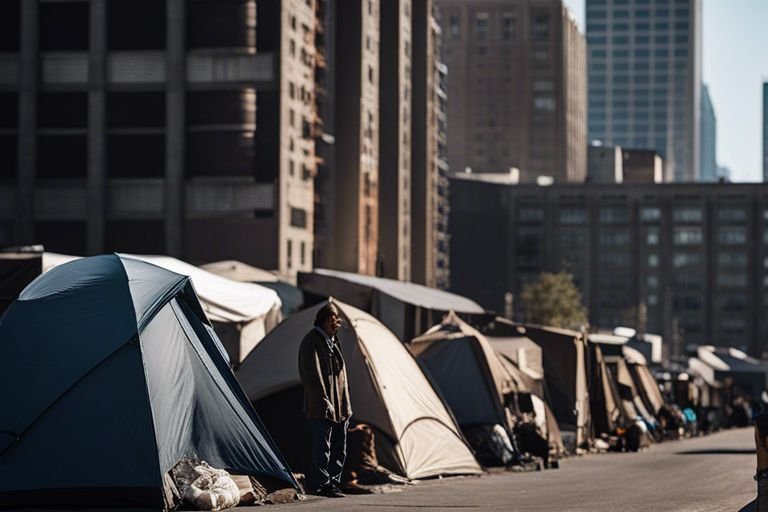Perambulating through the streets of Downtown Los Angeles, you cannot help but notice the stark contrast between the glittering skyscrapers and the grim reality of Skid Row. As I embarked on a journey to uncover the truth about this notorious area, I unearthed shocking statistics and eye-opening experiences that shed light on the severity of the situation. From rampant drug use and alarming crime rates to the scarcity of basic amenities, the harsh conditions in Skid Row pose a serious threat to the health and safety of its inhabitants. This guide will provide an in-depth look at the realities of Skid Row, offering valuable insights into the challenges faced by this marginalized community.
Key Takeaways:
- Skid Row is a significant area in Downtown LA. Skid Row encompasses a 54-block area in Downtown Los Angeles and is known for its high concentration of homelessness and poverty.
- The homelessness crisis in Skid Row is a complex issue. Various factors contribute to the homelessness crisis in Skid Row, including lack of affordable housing, mental illness, and substance abuse.
- Skid Row requires a multi-faceted approach to address its challenges. Effective solutions for Skid Row require a combination of affordable housing initiatives, mental health services, and substance abuse treatment programs.
- Advocacy and support for Skid Row residents are crucial. Community organizations and advocates play a vital role in providing essential services and working towards long-term solutions for those living in Skid Row.
- Understanding the reality of Skid Row is essential for meaningful change. By shedding light on the conditions in Skid Row, we can work towards creating a more equitable and compassionate society.
The Reality of Skid Row Los Angeles
The reality of Skid Row Los Angeles is a complex and harsh one. As I ventured into the heart of downtown LA, I was confronted with the stark truth of a community that has been marginalized and neglected for far too long. The sight of makeshift tents, overcrowded shelters, and individuals battling poverty and addiction was a sobering reminder of the deep-rooted issues that plague this area.
Types of homelessness in Skid Row
The homelessness crisis in Skid Row is multifaceted, with various forms of homelessness prevalent in the area. During my visit, I observed individuals living on the streets, families seeking refuge in temporary shelters, and a significant number of people struggling with chronic homelessness. The lack of affordable housing and access to mental health services has only exacerbated these challenges, leading to a cyclical pattern of poverty and trauma.
| Living situation | Stay in temporary shelters, living on the streets, chronic homelessness |
| Family homelessness | Families seeking refuge |
| Financial situation | Lack of affordable housing, poverty, trauma |
| Healthcare | Lack of access to mental health services |
| Challenges | Cyclical pattern of poverty and trauma |
Factors contributing to the homelessness crisis
There are a myriad of factors that have contributed to the homelessness crisis in Skid Row. Structural inequalities, lack of affordable housing, and the criminalization of homelessness have all played a role in perpetuating this crisis. Additionally, the lack of access to adequate mental health services and the prevalence of substance abuse have further complicated the situation. Assume that these challenges are deeply intertwined, making it difficult for individuals to escape the cycle of homelessness.
Navigating Downtown LA’s Skid Row
One of the most infamous areas in Los Angeles, Skid Row is a 54-block neighborhood located in Downtown LA. Known for its high concentration of homeless individuals and longstanding issues with poverty, addiction, and crime, Skid Row has gained a reputation as one of the most challenging areas to navigate in the city. As someone who has spent a significant amount of time in this area, I can attest to the unique challenges and complexities that come with exploring Skid Row.
Tips for staying safe in Skid Row
When venturing into Skid Row, it’s important to prioritize your safety. Here are some essential tips for staying safe in this area:
- Stay in well-lit areas and avoid walking alone, especially at night.
- Avoid engaging in confrontations and be respectful towards the residents.
- Keep your belongings secure and be mindful of your surroundings at all times.
The key to staying safe in Skid Row is to be aware and proactive. By following these guidelines, you can reduce the risk of encountering any potential dangers.
Step-by-step guide for helping the homeless in Skid Row
For those looking to make a positive impact in Skid Row, here is a step-by-step guide for helping the homeless individuals in the area:
| Step 1: Educate yourself about the issues facing the homeless population in Skid Row. | Step 2: Volunteer at local shelters or organizations that provide support to the homeless. |
| Step 3: Donate essential items such as food, clothing, and hygiene products to those in need. | Step 4: Advocate for policies and initiatives that address homelessness in Los Angeles. |
By taking these steps, you can contribute to the ongoing efforts to help the homeless community in Skid Row and make a meaningful difference in their lives.
Pros and Cons of Skid Row
To truly understand the reality of Skid Row, it’s important to consider both the positive and negative aspects of this community. Below, I have broken down the pros and cons into a table for a clearer comparison:
| Pros | Cons |
|---|---|
| Presence of community organizations providing support | High crime rates |
| Low-cost housing options | Health and sanitation issues |
| Access to free meals and social services | Lack of job opportunities |
| Sense of community and resilience among residents | Drug and substance abuse |
| Advocacy for homeless rights and services | Mental health challenges |
The positive impact of community initiatives
Amidst the challenges faced by Skid Row, there are inspiring community initiatives that have made a positive impact on improving the lives of residents. From local organizations providing food and shelter to grassroots efforts advocating for policy change, these initiatives are a testament to the resilience and strength of the community. They provide essential support and resources to individuals who are struggling, offering a glimmer of hope in the midst of adversity.
The negative effects of gentrification
Gentrification has brought about a wave of change in downtown Los Angeles, and while it has led to economic development in some areas, it has also had negative effects on the residents of Skid Row. The rapid increase in property values and redevelopment projects have resulted in the displacement of many long-term residents, exacerbating the homelessness crisis. Gentrification has also led to the loss of affordable housing options, making it even more difficult for individuals to find stable living arrangements in the area.

Conclusion
Drawing together all the information and experiences, I can confidently say that Skid Row in Los Angeles is undoubtedly a place of great need and suffering. The reality of downtown LA is eye-opening and forces us to confront the deep-seated issues of poverty and homelessness that plague this area. It’s clear that much more needs to be done to address the root causes of these issues and provide sustainable solutions for the individuals and families living in Skid Row. However, amidst the challenges and despair, there is also a sense of resilience and hope among the residents and organizations working to make a difference. It is up to us as a society to come together and support these efforts in order to truly uncover and address the reality of Skid Row and create a better future for those in need.
FAQ
Q: What is Skid Row Los Angeles?
A: Skid Row is a neighborhood in Downtown Los Angeles known for its high concentration of homeless individuals and shelters. It is a complex and often misrepresented area that requires a nuanced understanding to fully grasp its reality.
Q: How bad is the homelessness problem in Skid Row?
A: The homelessness problem in Skid Row is severe, with estimates of up to 4,200 people living on the streets. The area faces numerous challenges including lack of affordable housing, mental health issues, and substance abuse.
Q: Is it safe to visit Skid Row Los Angeles?
A: While it is important to approach the area with caution and respect, visiting Skid Row can be safe as long as you are mindful of your surroundings and avoid engaging in any risky behavior. It’s recommended to visit with a guided tour or as part of a volunteer initiative.
Q: What resources are available for the homeless in Skid Row?
A: Skid Row is home to numerous shelters, food banks, medical clinics, and outreach programs that aim to provide support and resources to the homeless population. Non-profit organizations and city initiatives work to bring essential services to those in need.
Q: How can I help make a positive impact in Skid Row Los Angeles?
A: There are several ways to contribute positively to the community, such as volunteering at local shelters, donating to reputable organizations, and advocating for policies that address homelessness. It’s crucial to educate oneself about the complexities of the issue and approach efforts with empathy and understanding.

